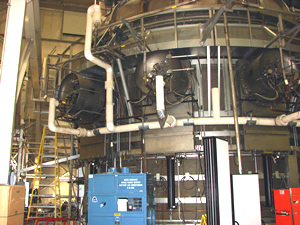Facility 290 is a vertical, very large Space Environment Simulation (SES) cryopumped test chamber capable of achieving ultra low pressure and a wide range of thermal conditions. Test articles are loaded through the top of the chamber using the Building 10 crane. Personnel entry is through a side opening access port. Two small viewports are located on the chamber side at different elevations. The chamber is used for thermal vacuum and thermal balance testing, and baking out very large test articles. |
 |
Mode of Operation
The test article is loaded onto the payload table or internal fixturing with the chamber dome rolled back. Often, special fixturing is required. An external clean air supply provides fresh air to the chamber during pre-test activities. Entry to instrument the payload with thermocouples, connect ground support equipment cabling, and install hardware is through a cleanroom airshower at the personnel door. Wearing of clean room garments is required. Scaffolding may be erected to provide access to the payload. An area adjacent to the main facility control console is reserved for the experimenter's ground support equipment. Ambient functional checks are normally performed. During temperature cycling, soak periods are observed for functional checks as specified in the test plan. A computer data terminal is provided with packaged software routines for temperature monitoring.
Chamber evacuation is provided by eight rotary piston mechanical pumps with Roots blowers, and eight cryopumps. A turbomolecular pump is available to pump the lighter gasses to achieve ultra low pressures. Thermal control is provided by an aluminum tube-in-sheet cylindrical shroud with both liquid nitrogen and gaseous nitrogen operational modes. The dome and bottom shrouds are also connected to the thermal skids. Resistance heater arrays, with external power supplies or gaseous nitrogen panels, are available for special thermal requirements. A thermoelectric quartz crystal microbalance (TQCM) and residual gas analyzer (RGA) provide both quantitative and qualitative monitoring of molecular contamination and gaseous constituents within the chamber. Closed circuit television coverage is available for monitoring the test article.
Parameters
Test Pressure: <13.3µPa (10-7 torr)
Shroud Temperature: -130°C to +100°C
Chamber Pumping Speed: 8 Cryopumps 240,000 lit/sec @ 133 µPa , Turbomolecular Pump 6,000 lit/sec @ 133 µPa
Physical Characteristics
Test Volume: 27' x 40'
Payload Support: 20,000 lb.
Removable Floor: 26,000 lb.
Viewports: 30 cm (12"), 2 each
Standard Electrical Feedthroughs: 37-pin, 7-pin, 4-pin, RF connectors
Integral Instrumentation
Pressure: Capacitance manometer - Atm to 10-3 mmHg
Ion Gauge: 10-3 mmHg to ultimate
Payload Temperature: 756 thermocouple channels
Contamination Monitor: TQCM, coldfinger, residual gas analyzer
|


